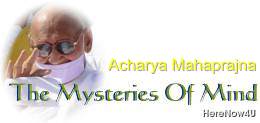
Those who have attained spiritual experiences after having abandoned sense-feelings adopt an attitude of neutrality in matters of pleasure and pain. This neutrality is the result of a second transformation of personality. But this state is not the final state of spiritual experience. The practitioner has to go beyond this state. He has to be extremely careful. He has to be constantly self-watchful in order to keep the flow of consciousness uninterrupted. He has to keep the flame of consciousness stable and ever burning. His experience does not remain stable and he is often attacked by inertia. The interplay of consciousness and inertia continues. It is only when the third ray of consciousness bursts forth, when experience becomes deeper and deeper and when discernment becomes more and more effective, that the interplay of inertia and consciousness comes to an end. Then the eternal light of wakefulness begins to shine in him without interruption. Before this light has begun to shine, the mind and actions remain apart because there is no connecting link between the two. They do not cohere and there is no coordination between them. With the dawn of enlightenment the autonomies of the mind and actions come to an end and they become harmonized in to a single current. This is called the unification of knowledge and conduct.
Philosophical thinkers are divided into two categories: those who emphasize the primacy of knowledge and those who emphasize the primacy of actions or conduct. This distinction first came into existence in the field of sadhana and from there it was transferred to the field of logic. Knowledge and conduct then came to be completely separated. It, however, does not hold much water in the field of sadhana anymore. We cannot keep knowledge detached from conduct. They form a unity. To speak of the two as separate is a matter of emphasis only. When the emphasis is placed on one, it does not exclude the other. However, in the course of time they came to be looked upon as separate. This gave birth to two distinct schools of philosophy.
In a state of enlightenment, the mind and the instincts go hand in hand with each other. The mind remains involved in each action and every action becomes a rational action. Every activity of the body becomes a conscious activity. Even instinctive activities take place under the auspices of consciousness. The enlightened man is always wakeful. He keeps the mind associated with every action he does. His mind never remains alienated from action. This wakefulness is the consequence of the third stage of the transformation of personality. Thinking and doing become a unity. With the further progress of sadhana and self-conscious-ness a fourth transformation takes place. It brings about a dispassionate attitude of mind. The practitioner arrives at the state of vitaraga. His consciousness becomes undefiled. The influence of the passions on his mind disappears. The self does not remain conditioned by external influences and comes to itself. The practitioner becomes centred in the self. His relationship with external things ceases. He becomes self-propelled. He develops pure and unconditioned knowledge. There is no difference between freedom from passions and pure knowledge or kaivalya. As a matter of fact kaivalya means freedom of knowledge from infiltration by passions. It means the rehabilitation of consciousness. Once consciousness has been rehabilitated, inertia disappears from it once for all. Disappearance of inertia results in a dispassionate attitude of the mind, which in its turn frees consciousness from further defilement. Kaivalya means the emergence of pure consciousness.
Once we get a glimpse of our native existence, we begin to command discernment, which is the precondition of the re-generation of man. Discernment enables us to develop a neutral attitude of mind. It is the first result of the perception of our real existence. Neutrality of the mind is the second result. Neutrality means two things: indifference and to see things from a close quarter. Only be who is neutral can see things in their true light. He who is not neutral is unable to do so. He becomes attached to that which is pleasing and opposed to that which is not. Attachments and aversions produce a defective understanding, which does not give us a correct picture of things.
Indifference means not to pay attention to or to discard. The neutral man is neither inclined towards pleasing things nor disinclined towards unpleasing things because he commands mental equilibrium or the sense of equality. Discernment produces neutrality, neutrality produces indifference and indifference brings about a balanced mind.
A complete reconstitution of personality is the tail end of sadhana. It implies a surrender of the empirical self or personality. This surrender leads to the emergence of man's real and unqualified existence. The boundary of unqualified existence of the self begins where the boundary of the empirical self ends. Having crossed the boundary of the empirical self we enter into our pure existence or in other words the self becomes rehabilitated in its own existence. It becomes the sole emperor of its realm. This is the outcome of sadhana. It is, however, difficult to achieve it.
Time is divided into three categories: the past, the present and the future. The Jainas use the term pratikramana (withdraw) with reference to the past, pratyakhyana (renunciation) with reference to the future and alocana (introspection) with reference to the present. Patanjali, the author of the Yoga Sutras, says that miseries, which are likely to happen, are to be avoided. The effects of deeds done in the past cannot be said to be undesirable because they have already been experienced and have become spent up. The deeds being done in the present are yet to mature, and, therefore, one should try to observe such deeds mentally. They cannot be stopped because man has to live, and, therefore, he must act. The effects of such deeds are yet to manifest themselves and have not been experienced. It is the future actions whose effects are yet to be experienced which are to be withdrawn from. They alone can be said to be undesirable. Thus one should mentally withdraw himself from past deeds, mentally observe himself from what is being done in the present and avoid future deeds. One need not regret what he had done in the past. The only thing he has to do with reference to the past is to withdraw the soul into its natural habitat. Present deeds are to be critically evaluated and watched. The greatest danger comes from future actions and they have to be avoided if they are likely to be undesirable.
The transformation of personality is impossible without avoiding the undesirable consequences of future deeds. There is no meaning in sadhana, if it does not bring about the transformation of personality. The practitioner has to disperse mental inhibitions. At least something has to be done in this respect. I am not talking about the ideal of vitaraga (passionlessness). Anyhow, this ideal has got to be kept in mind. Some kind of inner change has got to be begun. We do experience the succession of joys and sorrows, but the attempts to discipline the self can reach fruition only through the experience of pure joy. The habit to see life as a succession of joys and sorrows will then begin to break.
It is very difficult to remain constantly self-watchful, which is possible only after a long practice. Such a practice should, however, be undertaken not carelessly but carefully. One should resolve to act self-watchfully at least for an hour or two daily. He should walk or stand still with the consciousness that he is standing or walking. The mind and actions should go together. The integration of personality is impossible without such a conscious attitude. Sometimes we feel joy and at other times only sorrow. One should divert his attention from sorrows and try to feel joy only.
The practice of equanimity is a difficult task. We should not expect immediate results. We are not fully developed and free from the effects of our deeds, and, therefore, sadhana cannot be expected to bear fruits in a day or two. Anyhow, we should at least attempt to keep our knowledge as pure as possible. We should avoid the operation of feeling. The development of the sense of equanimity means the purity of knowledge. This is the initial process of the transformation of personality and if we cannot enter into such a process there is no sense in talking about it.
The potter places a lump of shapeless clay on the wheel and as soon as the wheel begins to revolve, the fingers of the potter begin to give shape to the clay. The clay will not take the shape of a pot unless this initial process has begun. The aim of the practitioner should be to give a new form to his personality. Unless the clay has been transformed into a pot, it will not be able to hold water.
The transformation of personality is the consummation of the process of sadhana.
 Acharya Mahaprajna
Acharya Mahaprajna

